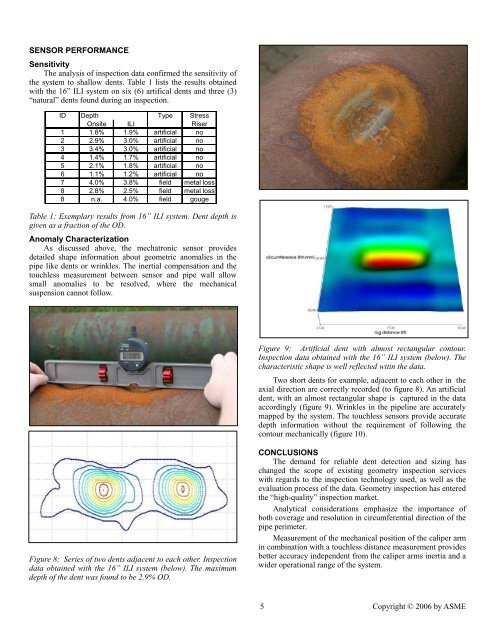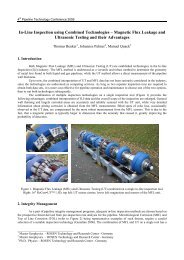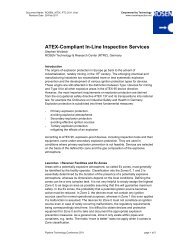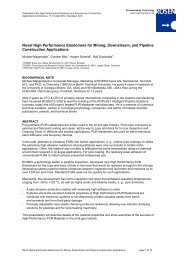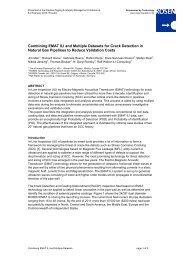View - ROSEN Inspection Technologies
View - ROSEN Inspection Technologies
View - ROSEN Inspection Technologies
Create successful ePaper yourself
Turn your PDF publications into a flip-book with our unique Google optimized e-Paper software.
SENSOR PERFORMANCE<br />
Sensitivity<br />
The analysis of inspection data confirmed the sensitivity of<br />
the system to shallow dents. Table 1 lists the results obtained<br />
with the 16” ILI system on six (6) artifical dents and three (3)<br />
“natural” dents found during an inspection.<br />
ID Depth Type Stress<br />
Onsite ILI Riser<br />
1 1.8% 1.9% artificial no<br />
2 2.9% 3.0% artificial no<br />
3 3.4% 3.0% artificial no<br />
4 1.4% 1.7% artificial no<br />
5 2.1% 1.8% artificial no<br />
6 1.1% 1.2% artificial no<br />
7 4.0% 3.8% field metal loss<br />
8 2.8% 2.5% field metal loss<br />
8 n.a. 4.0% field gouge<br />
Table 1: Exemplary results from 16” ILI system. Dent depth is<br />
given as a fraction of the OD.<br />
Anomaly Characterization<br />
As discussed above, the mechatronic sensor provides<br />
detailed shape information about geometric anomalies in the<br />
pipe like dents or wrinkles. The inertial compensation and the<br />
touchless measurement between sensor and pipe wall allow<br />
small anomalies to be resolved, where the mechanical<br />
suspension cannot follow.<br />
Figure 8: Series of two dents adjacent to each other. <strong>Inspection</strong><br />
data obtained with the 16” ILI system (below). The maximum<br />
depth of the dent was found to be 2.9% OD.<br />
Figure 9: Artificial dent with almost rectangular contour.<br />
<strong>Inspection</strong> data obtained with the 16” ILI system (below). The<br />
characteristic shape is well reflected witin the data.<br />
Two short dents for example, adjacent to each other in the<br />
axial direction are correctly recorded (to figure 8). An artificial<br />
dent, with an almost rectangular shape is captured in the data<br />
accordingly (figure 9). Wrinkles in the pipeline are accurately<br />
mapped by the system. The touchless sensors provide accurate<br />
depth information without the requirement of following the<br />
contour mechanically (figure 10).<br />
CONCLUSIONS<br />
The demand for reliable dent detection and sizing has<br />
changed the scope of existing geometry inspection services<br />
with regards to the inspection technology used, as well as the<br />
evaluation process of the data. Geometry inspection has entered<br />
the “high-quality” inspection market.<br />
Analytical considerations emphasize the importance of<br />
both coverage and resolution in circumferential direction of the<br />
pipe perimeter.<br />
Measurement of the mechanical position of the caliper arm<br />
in combination with a touchless distance measurement provides<br />
better accuracy independent from the caliper arms inertia and a<br />
wider operational range of the system.<br />
5 Copyright © 2006 by ASME


